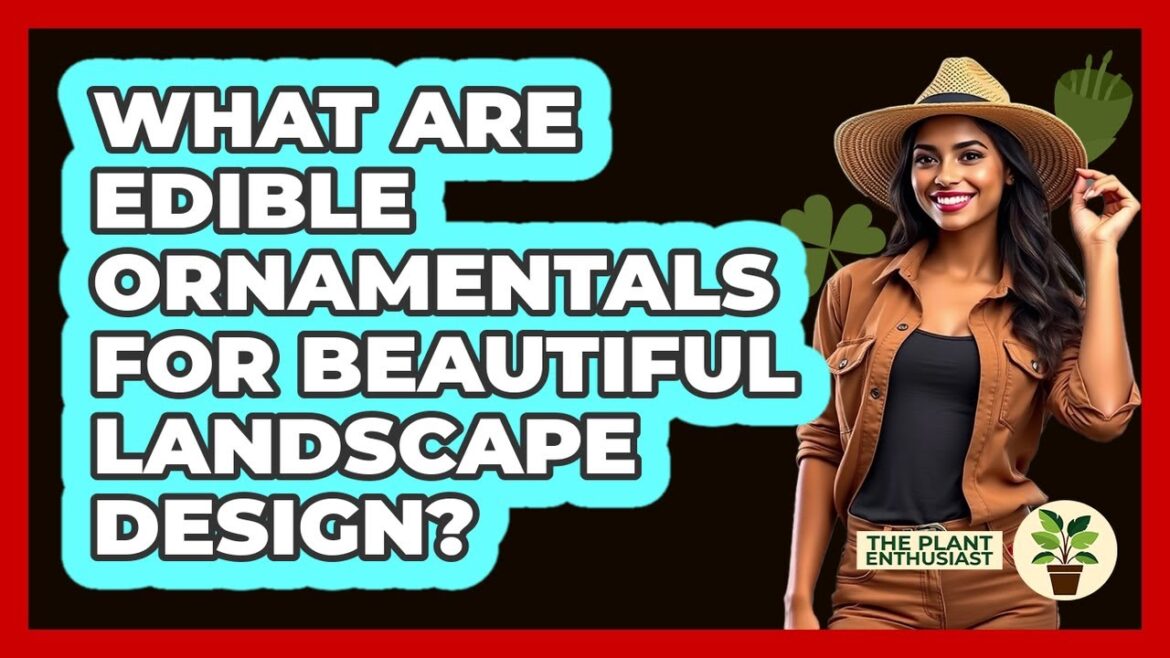What Are Edible Ornamentals For Beautiful Landscape Design? Are you interested in creating a garden that is both beautiful and productive? In this video, we’ll introduce you to the concept of edible ornamentals and how they can transform your landscape. We’ll explain what edible ornamentals are and how they combine visual appeal with functional food production. You’ll learn about different types of plants, including fruit trees, shrubs, vegetables, herbs, and edible flowers, that can be incorporated into your garden to add color, texture, and flavor all year round. We’ll discuss how to design with these plants, considering their size, shape, and seasonal changes, to create a lively and productive outdoor space. Whether you want to attract pollinators, support local wildlife, or grow your own fresh ingredients, edible ornamentals offer a practical and attractive solution. We’ll also share tips on selecting safe, non-invasive plants and maintaining a healthy garden using organic methods. Growing edible ornamentals not only enhances your landscape but also boosts food security and encourages outdoor activity. Join us as we explore how these versatile plants can help you create a garden that is both stunning and sustainable. Don’t forget to subscribe for more gardening tips and ideas!
⬇️ Subscribe to our channel for more valuable insights.
🔗Subscribe: https://www.youtube.com/@The-Plant-Enthusiast/?sub_confirmation=1
#EdibleGardening #Foodscaping #GardenDesign #SustainableGarden #EdibleLandscaping #PlantTips #OrganicGardening #HomeGarden #PollinatorFriendly #GrowYourOwnFood #GardenIdeas #LandscapeDesign #VegetableGarden #HerbGarden #PlantLovers
About Us: Welcome to The Plant Enthusiast, your go-to destination for everything related to the wonderful world of plants! Whether you’re a seasoned gardener or just starting your green journey, our channel is dedicated to nurturing your passion for plant care, cultivation, and creativity.
[Music] What are edible ornamentals for beautiful landscape design? Imagine walking through a garden where every plant not only catches ura but also offers something tasty. That’s the magic of edible ornamentals and landscape design. These plants are chosen for their visual appeal. bright flowers, colorful leaves, or interesting shapes while also providing edible parts like leaves, fruits, or flowers. They blend beauty and function, making your garden both attractive and useful. Traditional ornamental plants are mainly grown for looks, but edible ornamentals add a new layer. They feed people and wildlife. The idea is to pick plants that look good all year round and also produce food. This approach is called edible landscaping or foodcaping. It uses a mix of plants like perennials, annuals, shrubs, and trees. You can plant them in borders, beds, containers, or as focal points to create a lively, productive garden. Many plant groups fit into edible ornamentals. Fruit trees like apple, cherry, pear, and citrus trees bloom in spring, give shade in summer, and produce fruit in autumn. Shrubs like blueberry and aronia offer pretty spring flowers, summer berries, and colorful fall leaves. Service berry and rugosa rose add interest with flowers, fruit, and sometimes decorative hips or leaves. Vegetables can also be ornamental. Rainbow chard has bright stems and kale offers ruffled or purple leaves that look striking. Artichokes and cardons have architectural shapes while eggplants and peppers come in vibrant colors like purple, yellow, and red. Herbs like basil, thyme, oregano, and sage have attractive foliage and fragrant flowers, making them both beautiful and useful. Edible flowers such as ntoriums, chundula, pansies, and lavender add color and are safe to eat, brightening up beds and borders. Berry bushes like strawberries work well as ground covers, while raspberries and currants fill in shrub layers. Climbing beans and peas on trelluses or teepeees add vertical interest and save space. When designing with edible ornamentals, think about plant size, shape, color, and how they change with the seasons. Mix tall and short plants. Place vining types on supports and use colorful foliage or flowers to create themes. For example, a purple bed with kale, eggplant, anchives, or a yellow border with chardred, peppers, and chundula. Perennial edible ornamentals like fruit trees and berry bushes give your garden structure and don’t need replanting every year. Annuals like vegetables and flowers allow for rotation and trying new plants. Be careful to avoid invasive species and use safe organic methods to keep your plants healthy and edible. Beyond just looking good, edible ornamentals support local wildlife by attracting pollinators and beneficial insects. They also boost food security by providing fresh homegrown produce. These plants often need less maintenance than traditional ornamental plants, especially perennials. Growing edible ornamentals encourages outdoor activity and helps you connect with nature and the food you eat. From the plant’s point of view, being an edible ornamental means serving multiple roles in the garden. These plants are chosen for their ability to thrive in design spaces, adapt to local conditions, and interact with other plants and animals. Their success depends on where they are placed, how they are cared for, and your goals as a gardener. Their colorful flowers, fragrant leaves, and tasty fruits make them stand out in any garden. Using edible ornamentals shows that plants can be both beautiful and useful. When you combine these plants thoughtfully, you create a garden that is lively, rich in biodiversity, and personally rewarding. It’s a way to enjoy nature’s beauty while also growing your own food right outside your door. [Music]


Comments are closed.